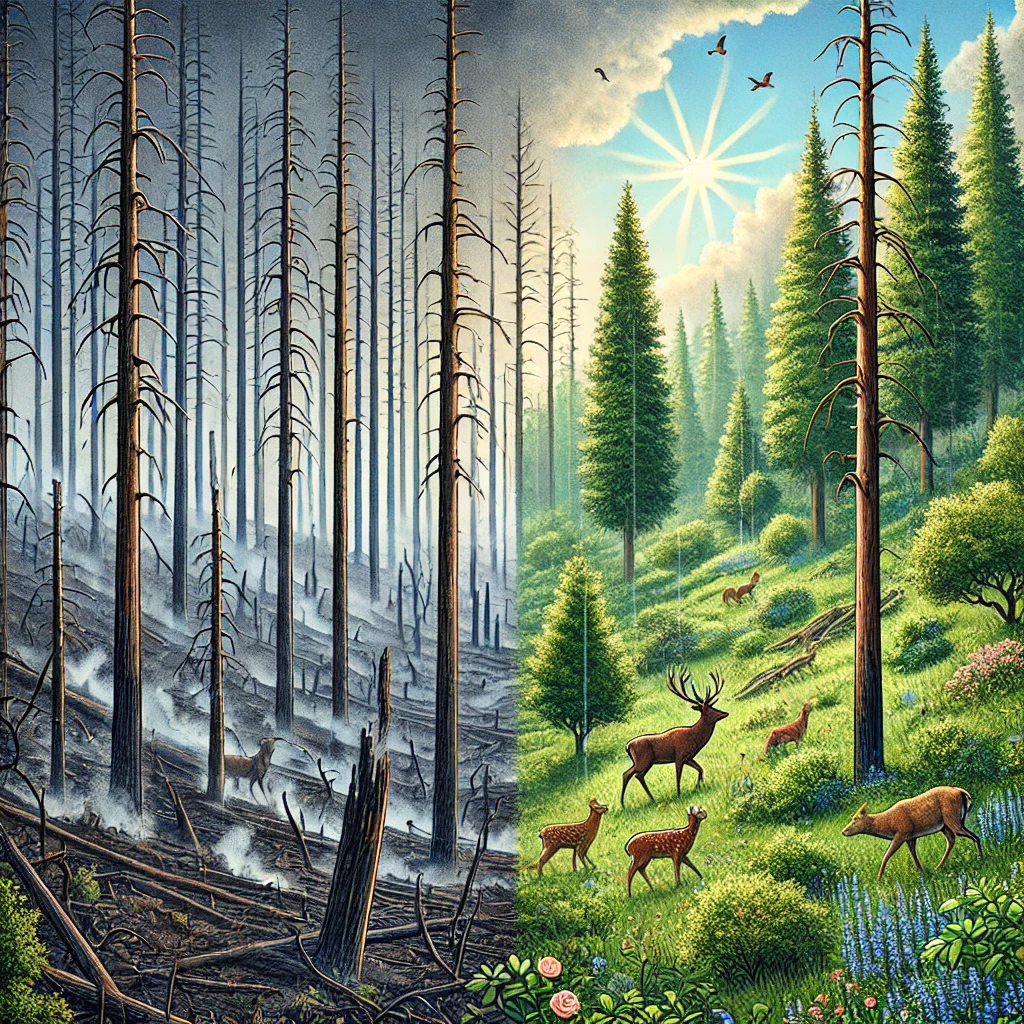Wildfires are natural occurrences that have shaped ecosystems for millions of years. However, with increasing frequency and intensity, particularly due to climate change, these events can bring both devastation and renewal to forest ecosystems. Understanding how wildfires impact biodiversity and the health of our forests can help us strike a balance between managing these events and protecting the environments that sustain life on Earth.
Immediate Effects: Destruction and Habitat Loss
The most apparent consequence of wildfires is the destruction of large forest areas, leading to habitat loss for many species. Trees, shrubs, and other vegetation are often decimated, leaving wildlife without food or shelter. This can be especially devastating for species with small or specific habitat ranges, such as endangered mammals or specialized insects. The immediate aftermath of a fire can force animals to migrate to new territories or face population declines.
Additionally, wildfires can destabilize the soil by removing vegetation that helps retain it. Without this natural protection, the land becomes more susceptible to erosion, and runoff can pollute nearby rivers and streams, degrading water quality. This erosion not only harms aquatic life but also affects the broader ecosystem that depends on clean water.
Air Quality and Human Health Risks
Wildfires don’t just impact the forests—they also affect the air we breathe. Smoke from large fires can travel vast distances, carrying harmful particulate matter that poses serious health risks to humans. Communities near and far from the fire’s source may experience respiratory issues, cardiovascular problems, and other health complications as a result of prolonged exposure to poor air quality. Additionally, the economic costs of wildfires—ranging from property damage to healthcare expenses and firefighting efforts—can strain both local and national resources.
How Wildfires Affect Forest Ecosystems and Air Quality
Despite their destructive nature, wildfires play a crucial role in maintaining the health of certain ecosystems. In fire-adapted environments, such as pine forests and savannas, periodic fires are necessary for ecological balance. Fires clear out dead wood, underbrush, and invasive plant species, making room for new growth. They also help release nutrients into the soil and allow sunlight to reach the forest floor, promoting the regeneration of native plants.
Some tree species, like certain pines, have evolved to depend on the heat from wildfires to open their cones and release seeds. This natural process helps ensure the continuation of these species and creates a more diverse ecosystem with a mix of mature and young vegetation, supporting various species and enhancing biodiversity.

The Role of Climate Change in Wildfire Intensity
Unfortunately, climate change is exacerbating the frequency and intensity of wildfires. Prolonged droughts, higher temperatures, and altered weather patterns have created drier conditions that are more prone to burning. These increasingly intense wildfires release vast amounts of carbon dioxide and other greenhouse gases into the atmosphere, contributing further to global warming. This dangerous feedback loop makes it even more critical to find sustainable methods for managing wildfires.
Sustainable Forest Management: A Key to Protecting Biodiversity
To mitigate the risks of uncontrolled wildfires while preserving the ecological benefits they bring, sustainable forest management practices are essential. Controlled burns, or prescribed fires, are one such tool that can reduce the risk of larger, more destructive wildfires. By intentionally burning small areas of forest under controlled conditions, we can eliminate excess vegetation and underbrush, reducing the likelihood of a massive, uncontrollable fire.
Forest thinning—removing smaller trees and dense undergrowth—can also reduce the fuel available to potential fires, making them less intense when they occur. Additionally, creating firebreaks, which are gaps in vegetation that prevent the spread of fire, can help protect vulnerable areas.
It’s also crucial to integrate traditional ecological knowledge, particularly from indigenous communities. Many indigenous cultures have used fire as a land management tool for centuries, and their practices can inform modern approaches to forest conservation. By embracing these methods, we can enhance the resilience of our forests and protect biodiversity.
The Path Forward: Balancing Fire and Conservation
The relationship between wildfires and biodiversity is complex. While wildfires can cause immediate destruction, they are also an essential part of many ecosystems, contributing to long-term health and sustainability. The challenge lies in finding a balance between preventing catastrophic fires and allowing nature’s cycles to unfold.
As the impacts of climate change continue to increase the frequency of wildfires, it’s more important than ever to adopt sustainable forest management practices. By doing so, we can help protect not only the forest ecosystems that support biodiversity but also the people and communities that depend on them.
Learn More About Wildfire Management and Biodiversity Conservation
At the EAT Community, we are passionate about promoting sustainable practices that benefit both the environment and the economy. To learn more about how we can help you integrate these principles into your work, visit us at EAT Community and join the conversation on making our planet a better place—one forest at a time.
Related Articles and Resources:
- Sustainable Forest Management: Nurturing Prosperity and Resilience
- Impacts of Deforestation on Forest Ecosystem Resilience and Biodiversity
- Extreme Wildfires Became Twice as Frequent and Intense in 20 Years, Study Finds
- What is sustainable forestry? Practices & Benefits
- Forest Health and Resilience: Navigating the Challenges of Climate Change
- Environmental, Business, and Public Emergencies: Do You Know What to Do?
- Wildfires
- Air Quality in China and Possible Global Impacts




Your blog post was like a crash course in [topic]. I feel like I learned more in five minutes than I have in months of studying.